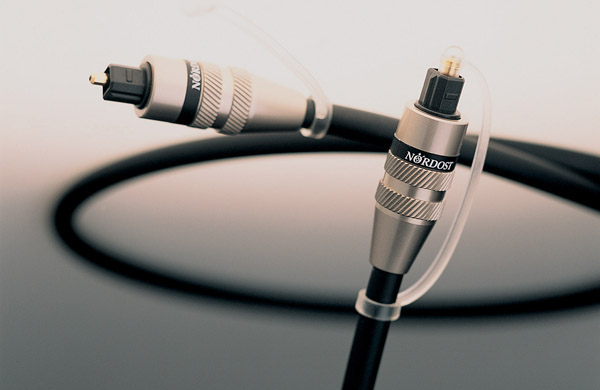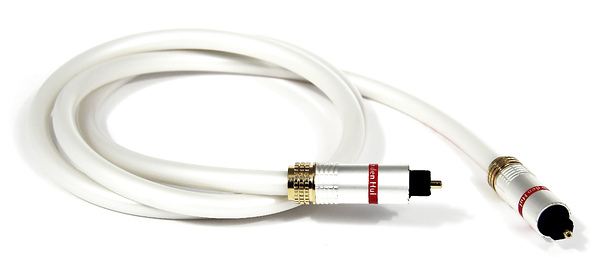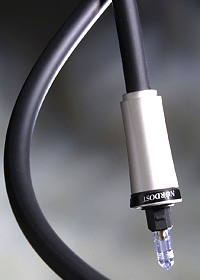THE SOUND Of LIGHT
Though humans cannot travel at the speed of light, an audio signal - after proper conversion - can do that. For long optical digital cables could not compete with coaxial connections and their use in high end audio was quite limited. Today, developments in material engineering enable to produce light-conveying fibers of such a grade that the situation is quite opposite: listening to the light may yield more pleasure than listening to electrical interferences of a coaxial cable.

Listening to the light
In principle, there are some major advantages of an optical cable connection, the biggest being absolute resistance to electrical noise and lack of ground connection. If you need make a digital connection between components that are far away then the optical cable is the best you can do to avoid problems that are associated with any other type of cable. Contrary to the popular misconception that transmitting and receiving parts use laser assemblies to send and receive the light, ordinary red LED diodes are photocells serve this purpose. The travelling light is not modulated – that is there is not more or less light transduced at a given moment. It is a digital connection, isn’t it? So the process is a simple ON-OFF switching event, however, happening with MHz speed.
The purity of an optical fibre matters the most to avoid losses (caused by internal reflections) – producers therefore employ various tactics to keep the light fresh and alive on both ends of a cable. As outlined in our preface, the new materials also helped an optical cable to be both transparent for a signal and flexible for a user.
For us, reviewers, there is also one more lovely hook: an optical cable does not need to be broken-in and its ´dielectric´does not discharge or recharge. Quite opposite – a new cable should be a better performer than a cable in use, as the latter may already exhibit some material defects due to manipulation.
The contenders
Wireworld Supernova 6 is the latest incarnation of top-of-the-line Wireworld’s optical cables. Where Nova 6 (this is the entry model of Wireworld) utilizes only single plastic conductor, the Supernova 6 comes with a multistrand of 280 glass filaments. Theoretically speaking, such an assembly should be more resistant to internal reflections of travelling signal – it means less of the signal attenuation that may happen in a single-wire assembly thanks to its bends and turns.
I cannot speculate to which extent the above statement can be agreed with and how much one can benefit from having the bunch of filaments inside the cable sonically – the real truth is that all other contenders in our test ran only one conductor along the length of a cable.

Van den Hul Optocoupler MkII comes in a mother-of-pearl colored jacket which gives the cable a nice optical appearance. Both ends of the fiber (where they lurk from terminations) are shaped into a convex lens. Van den Hul believes that it helps focusing of the light beam that consequently travels more easily through the center of the core and, again, suffers less from internal wall reflections – 50% less attenuation is claimed in the company’s literature.
The shape of the Optocoupler’s lens should also theoretically make the hand-over between the cable and a receiver/transmitter (that is the connector of transmitting or receiving device) much more precise. This is often quite an underestimated factor: the optical properties of a cable’s ending and a device’s connector should be about the same. If they are not there may be losses and reflections in the interface. In practice, finding the optical specifications of a device’s termination is far beyond our reach (and I am afraid that manufacturers do not pay attention to this at all) so please just treat the above explanation like a useful piece of information that may explain an occuring mismatch between a cable and a component.

The Optocoupler MkII does not specify if it uses plastic or glass, however, I assume there is a glass compound fiber in it. This is not necessarily a disadvantage – though glass conductors are (understandably) expected to have more lossless signal transmission they are also more vulnerable: I mean the defects and stress caused by bending that may result into a complete discontinuity of a signal, i.e. there is no signal passing through the cable anymore.
Fortunately enough, the comparisons between the glass and the plastic were a piece of cake for us during this test: Nordost Whitelight was available in both versions. The standard Whitelight features a high grade plastic fiber core surrounded with 3 layers of insulation. On the contrary, the Nordost Whitelight Glass uses a medical grade micropolished glass conductor and on top of the layered insulation it adds „internal damping mechanism“, whatever it means.

Performance
All the contenders were available in identical lengths of 1.0m and none of them represented an issue in practical use. In fact, the flexibility of the optical cables was higher than the bending capabilities of a standard audio cable of similar proportions. This is not to encourage you to coil the cables - the straighter the path the better for the lessloss transmission.
The weak point of any optical connection is its termination: it did not show particularly strong grip to a component’s Toslink inlet/outlet in any case. Unfortunately there is no existing standard for keeping a cable firmly locked and secured in a component’s terminations. Through the use we have to often check if the cable properly sits in place.
The listening tests appeared to be the most challenging of all the listening tests we have ever made. The cables were used to create the digital path between 4 components: Accuphase DP-78 (SACD player), Luxman D-06 (SACD player), Pioneer PDS-904 TM (CD player) and Behringer DEQ2496 (mastering processor). So they make link between respective transports and D/A converters or they were used to loop the digital signal for an external DSP (Behringer).
The good thing is that all the performers provided very transparent and pure sound. No matter which one was used, the optical cable proved to have excellent resolving qualities, good timing (that is: no audible imbalances in temporal information flow) and unlike an electrical connection (a coaxial cable) the sound of optics was free of stress, it was cleanly laid out without etch or glare. I suspect the latter to be also the effect of timing errors (jitter, if you want) that are not present with a optical cable. Unlike computers, where digital data move in blocks that are checked for completeness and no errors (like when you move a data file from an USB stick to your computer), audio signals are continuous streams and it is extremely important for the data to arrive not only complete and error-free but also just in time. It took quite a long before manufacturers recognized the jitter phenomenon in signal transmission between a transport and a DAC and were able to tackle it effectively.
The cables represented different price categories; the cheapest being the Nordost Whitelight (65€), followed by Van den Hul Optocoupler MkII (75€), Wireworld Supernova 6 (110€) and Nordost Whitelight Glass (150€).The next good thing therefore (even better, for sure) is that there was no audible difference between the optical cables in our test. Not to misinterpret this it just means that there was no difference for 1.0m runs – should a cable be required to be 5m long the results may be different. However, for standard home conditions it does not really matter which one you would choose.
As far as the plastic-glass dilemma is concerned I have to admit that I had a slight (read slightest) feeling that Nordost Whitelight Glass was a bit better than the Nordost Whitelight Plastic in terms of sonic clarity. However, when I blind-tested to try and confirm this observation I could not reliably distinguish between the two.
The last and good news again is that with the optical connection a user will avoid impedance mismatch that is always the threat for electrical connections. The sonic edge or distortion of some coaxial cables in certain applications can be easily mistaken for ´better´sound so be careful – we do not want to affect the passing signal neither in positive nor in negative way, do we?
Kontakt:
Nordost: Gaia Connections, Praha, tel. +420 286 885 599
Van den Hul: High-End Audio Studio, Belgická 4, Praha, tel. +420 224 256 844
Wireworld: Reference Cinemas, Praha, tel. +420 221 014 604



